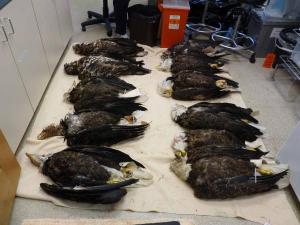By Sarah Farmer
Although humans are the most prominent victims, every vertebrate species is susceptible to lead poisoning. Birds, fish, reptiles, dogs, and cats are all at risk. During a February 16 symposium at the American Association for the Advancement of Science conference in Boston, researchers agreed that lead is pervasive and poses significant threats to living things.
Increasingly, scientists have realized that there is no such thing as a safe amount of lead exposure for humans of any age, or for any other vertebrates. The U.S. Centers for Disease Control (CDC) recently abandoned the idea that an acceptable level of exposure exists. Now, 5 µg/dL (micrograms per deciliter) is the new reference value for high blood lead levels in children — half the previous value.
Lead’s adverse effects on human health have been recognized for thousands of years, but lead continues to be used domestically and globally in a variety of industrial processes and consumer goods. When used as a fuel additive, lead is reduced to tiny particles that can float for weeks before settling on the ground in a filmy layer of dust. Exposure to this dust or to resuspended particles is the main cause of lead exposure in adults.
Dead bald eagles carpet the floor of a necropsy room, many of them poisoned by lead. Credit: Mark Pokras/Tufts UniversityA soft and malleable metal, lead has nowhere to go once it is mined. It persists in the environment with no degradation to lessen its toxicity. Lead is still used extensively in some types of small-scale smelting and battery recycling.
For people in parts of Africa who smelt lead ore to obtain gold, the toxic effects are amplified. Dr. Mary Jean Brown of the CDC explained that in some Nigerian villages, the smelting process starts with children who break the lead ore into smaller pieces by hand.
In these villages, the smelting process includes intimate contact with lead. The ore is milled by hand, sluiced, and spread out on feedsacks. “By this time, the lead particles are small and very soft, so children eat, sleep and play on the mats of lead and gold,” said Brown. “Some of the children in these areas had blood lead levels as high as 700 µg/dL.”
Such severe lead poisoning causes neurological damage and other problems. The CDC recommends that children with blood lead levels higher than 45 µg/dL should receive treatment to remove lead from their bodies.
Even in the United States, lead remains a problem. Lead additives in paint and gasoline have been curtailed, but not eliminated.
“Many people think the lead problem was solved 30 years ago,” said Dr. Mark Pokras of Tufts University in Medford, Mass. “However, we use more lead today than ever before.”
Some of that lead takes the form of bullets, shotgun shells and fishing equipment. These materials are the culprits in many wildlife poisonings, as a tidy row of dead bald eagles in Pokras's lab silently attests. Not all the bald eagles were killed by lead poisoning, but eagles are sensitive to lead poisoning and uniquely susceptible. As carnivores, they eat other animals that may have ingested fragments of lead bullets or still harbor a bullet in their organs and tissues.
California condors are in the same predicament. Despite efforts to protect them, lead poisoning could drive the species to extinction within our lifetimes.
Because of lead’s persistence, ubiquitous use, and suite of harmful effects in humans and animals, experts in all fields — along with public and political organizations — must work together to protect the people and animals most at risk of lead poisoning. As Pokras said, “We are more alike than we are different. We need to break down the institutional silos that separate research organizations.”
Sarah Farmer is a biology major at the University of North Carolina in Asheville. She contributes to the USDA Forest Service Southern Research Station’s blog, CompassLive. Reach her at sfarmer@unca.edu.

